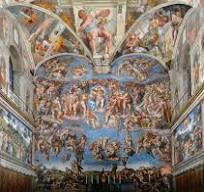The Last Judgment by Michelangelo
Michelangelo’s masterpiece, “The Last Judgment,” is a monumental fresco located on the altar wall of the Sistine Chapel in Vatican City. Painted between 1536 and 1541, this awe-inspiring work of art depicts the second coming of Christ and the final judgment of souls.
In this dramatic portrayal, Michelangelo skillfully captures the moment when Christ, seated in glory, separates the blessed from the damned. The composition is filled with dynamic movement and intense emotion, as figures rise and fall, expressing fear, hope, and despair.
The central figure of Christ is a commanding presence, with his outstretched arms and piercing gaze symbolizing divine authority and mercy. Surrounding him are angels, saints, and apostles, each depicted with exquisite detail and expression.
At the bottom of the fresco, souls are shown being raised from their graves and ascending to heaven or descending to hell. The damned are tormented by demons, while the saved are welcomed by angels into paradise. The overall composition conveys a sense of urgency and drama befitting its subject matter.
Michelangelo’s mastery of anatomy and form is evident in the muscularity and dynamism of his figures. The play of light and shadow adds depth and dimension to the scene, creating a powerful visual impact that draws viewers into the unfolding drama.
“The Last Judgment” stands as a testament to Michelangelo’s artistic genius and his ability to convey profound spiritual themes through visual storytelling. It remains one of the most iconic works of Renaissance art, continuing to inspire awe and admiration centuries after its creation.
Exploring Michelangelo’s Masterpiece: 7 Insights into The Last Judgment in the Sistine Chapel
- The Last Judgment by Michelangelo is a famous fresco located on the altar wall of the Sistine Chapel in Vatican City.
- The fresco depicts the second coming of Christ and the final judgment of souls, with the saved ascending to heaven and the damned being cast into hell.
- Michelangelo worked on The Last Judgment from 1536 to 1541, completing it during the Counter-Reformation period in Catholic Church history.
- The artwork is known for its dramatic and dynamic composition, with figures shown in various emotional states reflecting their fate.
- The central figure of Christ is a powerful and imposing presence, surrounded by angels, saints, and other celestial beings.
- Critics at the time were divided over Michelangelo’s portrayal of nudity in some figures, which was seen as controversial for that era.
- Visitors can still view The Last Judgment in the Sistine Chapel today, where it remains a significant work of Renaissance art.
The Last Judgment by Michelangelo is a famous fresco located on the altar wall of the Sistine Chapel in Vatican City.
The Last Judgment by Michelangelo is a renowned fresco adorning the altar wall of the Sistine Chapel in Vatican City. This iconic masterpiece, painted between 1536 and 1541, depicts the final judgment of souls and the second coming of Christ. Michelangelo’s powerful portrayal captures the intensity of the moment as Christ separates the blessed from the damned, surrounded by a multitude of figures conveying a range of emotions. The fresco’s central placement within the Sistine Chapel highlights its significance and enduring impact on art history and religious iconography.
The fresco depicts the second coming of Christ and the final judgment of souls, with the saved ascending to heaven and the damned being cast into hell.
The iconic fresco by Michelangelo, “The Last Judgment,” vividly portrays the momentous event of the second coming of Christ and the ultimate judgment of souls. In this powerful depiction, the blessed are shown ascending to heaven, guided by angels towards eternal bliss, while the damned are depicted being cast into hell, where they face torment and despair. Michelangelo’s masterful composition captures the stark contrast between salvation and damnation, emphasizing the profound consequences of one’s actions and beliefs in the afterlife.
Michelangelo worked on The Last Judgment from 1536 to 1541, completing it during the Counter-Reformation period in Catholic Church history.
During the Counter-Reformation period in Catholic Church history, Michelangelo dedicated his artistic talents to creating “The Last Judgment” from 1536 to 1541. This monumental fresco in the Sistine Chapel stands as a testament to his commitment to portraying spiritual themes with unparalleled skill and depth. Amidst the religious fervor of the time, Michelangelo’s work on this masterpiece captured the essence of divine judgment and redemption, resonating with viewers then and continuing to captivate audiences with its profound symbolism and artistic excellence today.
The artwork is known for its dramatic and dynamic composition, with figures shown in various emotional states reflecting their fate.
The Last Judgment by Michelangelo is renowned for its dramatic and dynamic composition, showcasing figures depicted in a range of emotional states that mirror their ultimate fate. From expressions of fear and despair among the damned to those of hope and salvation among the blessed, Michelangelo skillfully captures the intense emotional journey of souls facing judgment. This contrast in emotions adds depth and complexity to the artwork, drawing viewers into the powerful narrative unfolding before them.
The central figure of Christ is a powerful and imposing presence, surrounded by angels, saints, and other celestial beings.
In Michelangelo’s depiction of “The Last Judgment,” the central figure of Christ emerges as a commanding and formidable presence, exuding power and authority. Positioned amidst a celestial entourage of angels, saints, and other divine beings, Christ’s imposing stature and intense gaze convey a sense of judgment and mercy. The composition skillfully captures the reverence and awe inspired by this pivotal moment of divine reckoning, with each figure meticulously rendered to emphasize their role in the grand narrative unfolding before the viewer.
Critics at the time were divided over Michelangelo’s portrayal of nudity in some figures, which was seen as controversial for that era.
During the time of its creation, critics were divided over Michelangelo’s depiction of nudity in some figures in “The Last Judgment,” finding it controversial for that era. The artist’s bold choice to portray the human form in its natural state sparked debates about propriety and artistic expression. Despite the controversy, Michelangelo’s fearless approach to representing the naked body added a layer of rawness and vulnerability to the composition, challenging conventional norms and inviting viewers to confront deeper themes of truth and authenticity within the context of divine judgment.
Visitors can still view The Last Judgment in the Sistine Chapel today, where it remains a significant work of Renaissance art.
Visitors can still view The Last Judgment in the Sistine Chapel today, where it remains a significant work of Renaissance art. The opportunity to witness Michelangelo’s masterpiece firsthand allows viewers to appreciate the intricate details, emotional intensity, and profound themes depicted in this iconic fresco. As one stands in the presence of this monumental artwork, the impact of its composition and storytelling serves as a reminder of Michelangelo’s enduring legacy and his unparalleled contribution to the world of art.




